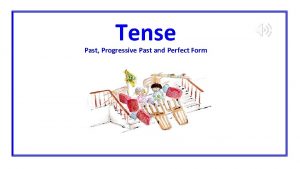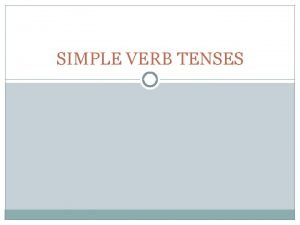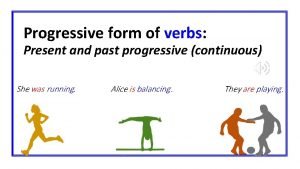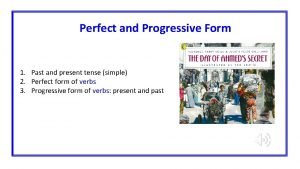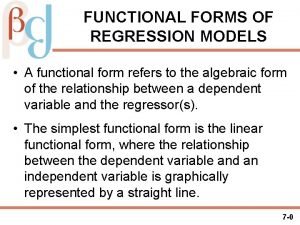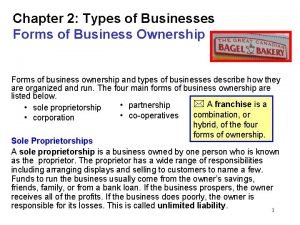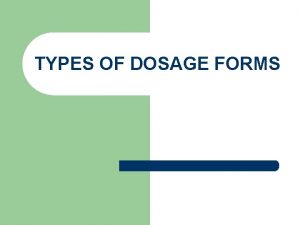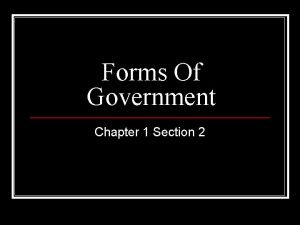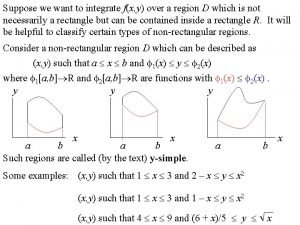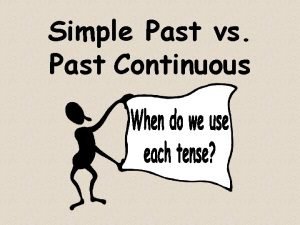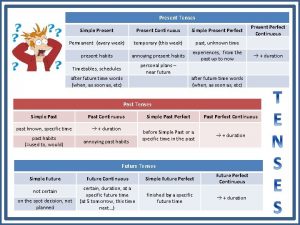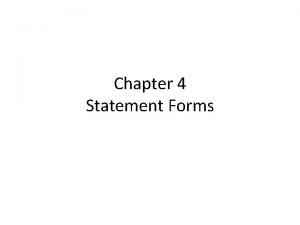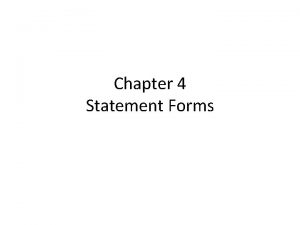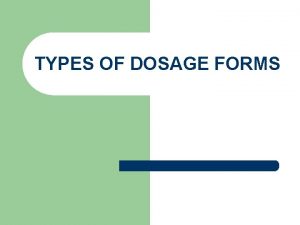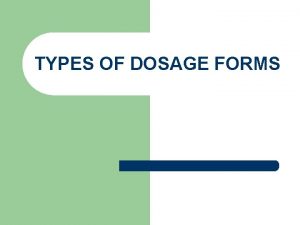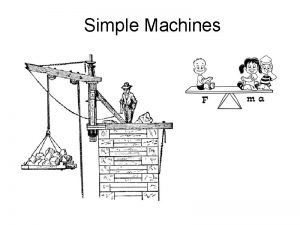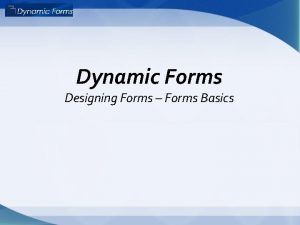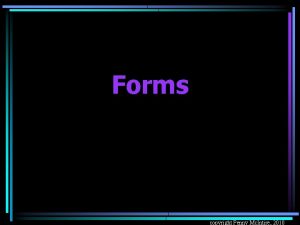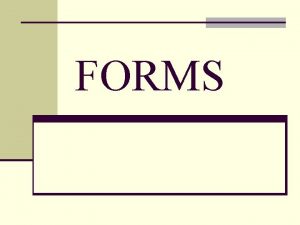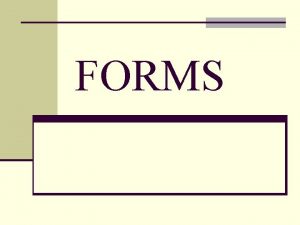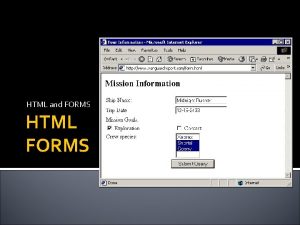Chapter 4 Statement Forms Statement types 1 Simple













































- Slides: 45

Chapter 4 Statement Forms

Statement types 1. Simple statements expression; println(“The total is “ + total + “. ”); (method call) 2. Compound statements { statement 1; . . . statementn; }

3. Control statements Conditional statements: if, switch Iterative statements: for, while Example: Add more than 2 integers Three startegies Duplicating the code in Add 2 Integers; Repeating the input cycle a predetermined number of times; Repeating the input cycle until the user enters a special sentinel value;

public class Add 4 Integers extends Console. Program { public void run() { println(“This program adds four integers. ”); int n 1 = read. Int(“ ? “); int n 2 = read. Int(“ ? “); int n 3 = read. Int(“ ? “); int n 4 = read. Int(“ ? “); int total = n 1 + n 2 + n 3 + n 4; println(“The total is “ + total + “. ”); } } • Difficult to generalize • Cumbersome to add 100 values

The repeat-N-times idiom for (int i = 0; i < N; i++) { statements to be repeated } • header line: for (int i = 0; i < N; i++) • body: statements to be repeated

/* * file: Add. NIntegers. java * ---------------* This program adds a predefined number of integers * and them prints the total. To change the number of * integers, change the definition of N_VALUES */ Import acm. program. *;

public class Add. NIntegers extends Console. Program { public void run() { println(“This program adds “ + N_VALUES + “integers. ”); int total = 0; for (i = 0; i < N_VALUES; i++) { int value = read. Int(“ ? “); total += value; } println(“The total is “ + total + “. ”); } /* specifies the number of values */ private static final int N_VALUES = 4; }

Tracing the program public void run() { println(“This program adds “ + N_VALUES + “integers. ”); int total = 0; for (i = 0; i < N_VALUES; i++) { int value = read. Int(“ ? “); total += value; } println(“The total is “ + total + “. ”); } N_VALUES (4) total (0) i (0) value ( )

The repeat-until-sentinel Read numbers until the user signals the end of input data. Sentinel: A special value, not a legitimate data value, signals the end of input data. Examples • Add a list of integers sentinel: 0 • Average grades Sentinel: -1

Repeat-until sentinel idiom while (true) { prompt user and read in a value if (value == sentinel) break; rest of the loop body }

A sample output This program adds a list of integers. Enter values, one per line, using 0 to signal the end of the list. ? 1 ? 2 ? 3 ? 0 This total is 6.

/* * File: Add. Integer. List. java * ----------------* This program reads integers one per line until the * user enters a special sentinel value to signal the * end of the input. At that point, the program prints * the sum of the numbers entered so far. */ import acm. program. *;

public class Add. Integer. List extends Console. Program { public void run() { println(“This program adds a list of integers. ”); println(“Enter values, one per line, ”); println(“using “ + SENTINEL + “ to signal the end of the list. ”); int total = 0; while (true) { int value = read. Int(“ ? “); if (value == SENTINEL) break; total += value; } println(“The total is “ + total + “. ”); } /* Specifies the value of the sentinel */ private static final int SENTINEL = 0; }

Tracing the program int total = 0; while (true) { int value = read. Int(“ ? “); if (value == SENTINEL) break; total += value; } println(“The total is “ + total + “. ”); } SENTINEL (0) total (0) value ( )

Average grade Changes • new variable: int count • new variable: double average • SETINEL = -1 • comments

public class Average. Grade extends Console. Program { public void run() { println(“This program calculates average grades. ”); println(“Enter grades, one per line, ”); println(“using “ + SENTINEL + “ to signal the end of the list. ”); } int total = 0; int count = 0; while (true) { int value = read. Int(“ ? “); if (value == SENTINEL) break; total += value; count++; } double average = (double) total / count; println(“The average is “ + average + “. ”); /* Specifies the value of the sentinel */ private static final int SENTINEL = -1; }

Zeros are not counted int total = 0; int count = 0; while (true) { int value = read. Int(“ ? “); if (value == SENTINEL) break; if (value > 0) { total += value; count++; } } double average = (double) total / count; println(“The average is “ + average + “. ”);

What if count = 0? int total = 0; int count = 0; while (true) { int value = read. Int(“ ? “); if (value == SENTINEL) break; if (value > 0) { total += value; count++; } } if (count == 0) { println(“No grades entered. ”); } else { /* count > 0 */ double average = (double) total / count; println(“The average is “ + average + “. ”); }

Example: Is. Leap. Year. java /* * File: Is. Leap. Year. java * -------------* * This program reads in a year and determines whether it is a * leap year. A year is a leap year if it is divisible by four, unless * it is divisible by 100. Years divisible by 100 are leap years only * if divisible by 400. */ Import acm. program. *;

public class Is. Leap. Year extends Console. Program { public void run() { println(“This program checks for leap years. ”); int year = read. Int(“Enter year: “); boolean is. Leap. Year = (((year % 4) == 0) && ((year % 100) != 0)) || ((year % 400) == 0); if (is. Leap. Year) { println(year + “ is a leap year. ”); } else { println(year + “ is not a leap year. ”); } } }

Four forms of if statements Single-line if (condition) statement Multiline if (condition) { statements; } if-else if (condition) { statement 1 } else { statement 2 }

Cascading if (condition 1) { statements 1 } else if (condition 2) { statements 2. . . } else { statements }

Example: Sign of x If x > 0, sign(x) = 1; if x < 0, sign(x) = -1; if x == 0, sign(x) = 0. Using a table x sign(x) >0 1 <=0 <0 =0 -1 0

The ? : operator condition ? expression. T : expression. F equivalent to if (condition) { expression. T } else { expression. F }

Examples • Max = (x >y)? x : y; • println(n. Items + “item” + ((n. Items == 1) ? “” : “s”) + “ found. ”);

The switch statement switch (e) { case c 1: statements 1 break; case c 2: statements 2 break; . . . more case clauses. . . default: statements break; } Useful when program must choose among several cases.

Good programming practice • Although a break is not necessary for each case, it is advised to include a break at the end of each case. • Although a default clause is optional, it is advised to include a default clause unless you are absolutely sure that you have covered all the cases (using a table).

Example public void run() { println(“This program shows the number of days in a month. ”); int month = read. Int(“Enter numeric month (Jan = 1): “); switch (month) { case 2: println(“ 28 days (29 in leap years)”); break; case 4: case 6: case: 9 case 11: println(“ 30 days”); break; case 1: case 3: case 5: case 7: case 8: case 10: case 12: println(“ 31 days”); break; default: println(“Illegal month number”); break; } } Tracing the program.

The while statement while (condition) { statements } • The conditional test is performed only at the beginning of a loop cycle. If the condition happens to become false at some point in the middle of the loop, the program doesn’t notice the fact until it has executed a complete cycle. At that point, the program evaluates the test condition again. If it is still false, the loop terminates. • If you must quit loop inside a cycle, use break. See later.

Example: Digit. Sum Pseudo code: public void run() { println(“This program sums the digits in an integer. ”); int n = read. Int(“Enter a positive integer: “); int dsum = 0; for each digit in the number, add that digit to dsum; println(“The sum of the digits is “ + dsum + “. ”); }

Find digits in an integer 1729 % 10 = 9 1729 / 10 = 172. . . 1 % 10 = 1 1 / 10 = 0 /* for each digit in the number, add that digit to dsum */ while (n > 0) { dsum += n % 10; n /= 10; }

public void run() { println(“This program sums the digits in an integer. ”); int n = read. Int(“Enter a positive integer: “); int dsum = 0; while (n > 0) { dsum += (n % 10); n = n /10; } println(“The sum of the digits is “ + dsum + “. ”); } Trace the program.

Loop terminationg • When you use a while loop in a program, it is important to make sure the loop eventually terminates. while (n >= 0) { dsum += n % 10; n /= 10; } Infinite loop! • Find out the command sequence on your computer which stops an infinite loop.

The loop-and-half patterns while (true) { prompt user and read in a value if (value == sentinel) break; process the data value } or the sentinel-based loop Prompt user and read in a value while (value != sentinel) { process the data value prompt user and read in a value }

Two drawbacks of the sentinel-based loop: 1. The order of the operations in the loop in unnatural, hard to follow. (Process the data value, then read in a new value. ) 2. Duplication of code presents a serious maintenance problem. Subsequent edits to one copy might not be made in the other.

The for statement for (init; test; step) { statements } Example: countdown Int START = 10; for (int t = START; t >= 0; t--) { println(t); } println(“Liftoff!”);

The expressions init, test, and step are each optional, but semicolons must appear. • If init is missing, no initialization is performed; • If test is missing, it is assumed to be true; • If step is missing, no action occurs between loop cycles. for ( ; ; ) is equivalent to while (true)

Effect of each of the following for statements for (int i = 0; i < N; i++) for (int i = 1; i <= 10; i++) for (int n = 99; i >= 1; n -= 2) for (int x = 1; x <= 1024; x *= 2)

Simple graphic animation Moving a square diagonally. /* File: Animated. Square. java * ------------------* This program animates a square so that it moves from the * upper left corner of the window to the lower right corner. */ import acm. graphics. *; import acm. program. *;

public class Animated. Square extends Graphics. Program { public void run() { GRect square = new Grect(0, 0, SQUARE_SIZE); square. set. Filled(true); add(square); double dx = (double) (get. Width() – SQUARE_SIZE) / N_STEPS; double dy = (double) (get. Height() – SQUARE_SIZE) / N_STEPS; for (int i = 0; i < N_STEPS; i++) { square. move(dx, dy); pause(PAUSE_TIME); } /* private constants */ private static final int N_STEPS = 1000; private static final int PAUSE_TIME = 20; private static final int SQUARE_SIZE = 50; }

for vs while for (init; test; step) { statements } is equivalent to Init; while (test) { statements step; } Prefer for over while, when you have choice.

Nested for statements 2 D applications. Example: Checkerboard /* * File: Checkerboard. java * ----------------* This program draws a checkerboard. The dimensions of * checkerboard are specified by the constants N_ROWS and * N_COLIMNS, and the size of the square is chosen so that the * checkerboard fills the available vertical space. */ import acm. graphics. *; import acm. program. *;

public class Checkerboard extends Graphics. Program { public void run() { double sq. Size = (double) get. Height() / N_ROWS; for (int i = 0; i < N_ROWS; i++) { for (int j = 0; j < N_COLUMNS; j++) { double x = j * sq. Size; double y = i * sq. Size; GRect sq = new GRect(x, y, sq. Size); sq. set. Filled(((i + j) % 2) != 0); add(sq); } /* for j */ } /* for i */ /* private constants */ private static final int N_ROWS = 8; private static final int N_COLUMNS = 8; }

Using for with floating-point data double h = 0. 1; for (double x = 1. 0; x <= 2. 0; x += h) { println(x); } Output: 1. 0 1. 1 1. 200000002. . . 1. 900000008

Why? Decimal 0. 1 cannot be exactly represented in binary. During the assignment h = 0. 1, decimal 0. 1 is rounded to it closest double floating-point, which is slightly larger than 0. 1. Caution: more rounding errors occur during addition. for (double x = 0. 0; x <= 0. 5; x += h) { println(x); } The final value of x is 0. 5 exact.
 Why are related forms more agreeable than unrelated forms
Why are related forms more agreeable than unrelated forms Contracted form of i will
Contracted form of i will Why are related forms more agreeable than unrelated forms
Why are related forms more agreeable than unrelated forms Why are related forms more agreeable than unrelated forms?
Why are related forms more agreeable than unrelated forms? Weak and strong forms
Weak and strong forms Simple present, simple past, simple future
Simple present, simple past, simple future Present simple past simple future simple
Present simple past simple future simple Past continuous present simple
Past continuous present simple Present continuous past continuous future continuous
Present continuous past continuous future continuous Future simple in the past
Future simple in the past Present continuous vs future simple exercises
Present continuous vs future simple exercises Tense chart for class 3
Tense chart for class 3 Be present simple
Be present simple Present simple past simple future simple
Present simple past simple future simple Simple and progressive forms
Simple and progressive forms Ann plays handball very well
Ann plays handball very well Present progressive form of the verb
Present progressive form of the verb Present and past progressive
Present and past progressive Play present continuous form
Play present continuous form Simple present tense structure
Simple present tense structure Affirmative and negative statements examples
Affirmative and negative statements examples Systems and forms design
Systems and forms design Market forms of poultry being sold
Market forms of poultry being sold What is functional form
What is functional form Types of water forms
Types of water forms Types of indeterminate forms
Types of indeterminate forms What is natural form
What is natural form Types of business forms
Types of business forms Topical dosage forms
Topical dosage forms Definition of semi solid dosage form
Definition of semi solid dosage form Water forms
Water forms Paint dosage form
Paint dosage form Types of solid dosage forms
Types of solid dosage forms Evaluation test for semisolid dosage form
Evaluation test for semisolid dosage form Doses form of drug
Doses form of drug 5 forms of business ownership
5 forms of business ownership 18.4 participating in a job interview
18.4 participating in a job interview Chapter 17:1 developing job-keeping skills
Chapter 17:1 developing job-keeping skills Forms of government chapter 1 section 2
Forms of government chapter 1 section 2 Chapter 408
Chapter 408 Chapter 1 section 2 forms of government
Chapter 1 section 2 forms of government Making simple electrical gadgets
Making simple electrical gadgets X simple and y simple
X simple and y simple Simple predicate
Simple predicate Simple past vs past continuous
Simple past vs past continuous Run present perfect
Run present perfect














